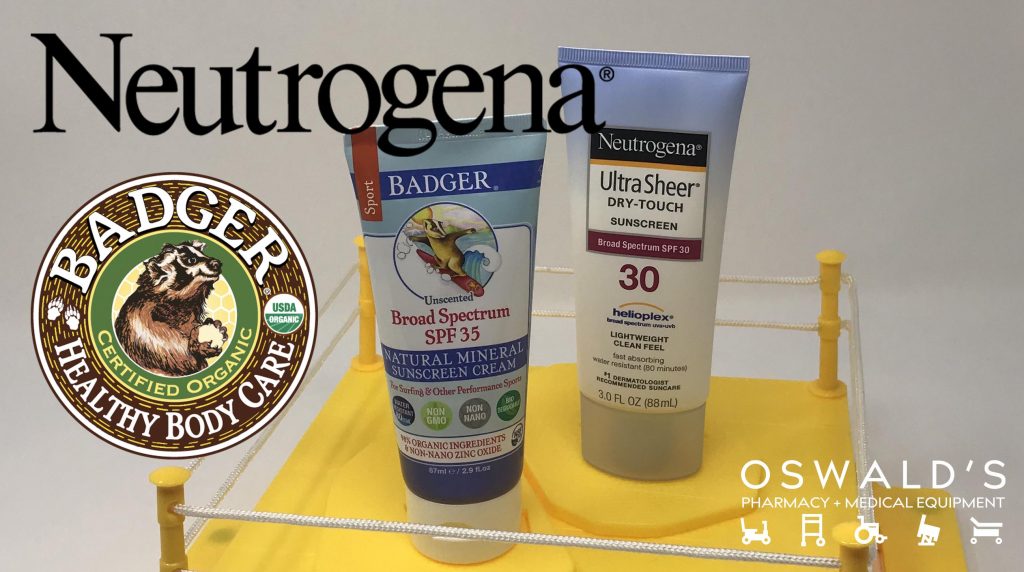Active Ingredients in Sunscreen
As summer is winding down, you may be squeezing in your last few days of sunshine at Centennial Beach, a local park or maybe just out in your backyard. Although the days are getting shorter, the sun is still as strong as ever and it’s important to protect your precious skin from the sun!
Here at Oswald’s, we have a vast array of sunscreens, which may leave our customers wondering “what are the differences and how the heck do you choose the right SPF?” Well, I’m here to share some sunscreen knowledge, including what ingredients are in popular sunscreens and what new alternatives are available!
How Sunscreen Works
To begin, I’ll give you a quick lesson on how SPF and sunscreens work.
There are two main ways that sunscreen protects our skin. The first is as a sunblock. The ingredients in sunblocks reflect damaging UV rays from the sun, avoiding absorption. The second way active sunscreen ingredients work is by absorbing the sun’s rays and releasing them as heat.
The SPF, or Sun Protection Factor, represents how long the sunscreen will protect us from getting sunburn. SPF can be multiplied by how long it usually takes us to burn. This will determine how long the sunscreen will protect us.
For instance; if you usually burn after 15 minutes, then SPF15 should protect you for 225 minutes. Keep in mind that SPF levels only apply if you are diligent when it comes to sunscreen application and care. Most of us aren’t, so it’s recommended that we reapply at least every two hours.
If you need some help finding the right SPF for you, check out Banana Boat’s SPF Guide.
Popular Active Sunscreen Ingredients
The nine most common active ingredients in sunscreens include oxybenzone, octinoxate, homosalate, octisalate, octocrylene, titanium dioxide, zinc oxide, avobenzone and mexoryl SX. These ingredients are seen in many sunscreens from big brand names like Coppertone and Neturogena to natural sunscreens including Badger and Jason.
Toxicity Concerns of Active Sunscreen Ingredients
The Environmental Wellness Group, or EWG, has taken it upon themselves to rank these nine ingredients based on their toxicity concerns. Keep in mind, there is still a lot of research that needs to take place on these chemicals and these evaluations are only based on a few minor studies. This is still helpful information for all consumers to bear in mind when shopping for sunblock.
The two major concerns with these ingredients are skin irritation and hormone disruption. EWG evaluated research findings and summarized them in a table found here.
I’ve gone ahead and summarized the high-level findings for you. The EWG had three groupings of toxicity concerns – higher toxicity concerns, moderate toxicity concerns and lower toxicity concerns. In short, oxybenzone and octinoxate are ingredients with higher toxicity concerns. Homosalate, octisalate and octocrylene have moderate concerns. Titanium dioxide, zinc oxide, avobenzone and mexoryl SX have lower toxicity concerns.
This information is by no means definitive, but it is helpful for consumers to be aware of potential risks.
Options with Low Toxicity Concerns
While all sunscreen active ingredients were ranked based on toxicity by the EWG, a handful ranked with lower toxicity concerns. These lower toxicity level ingredients are used in many “alternative” sunscreens that are currently available. We’re proud to carry a large selection of toxicity-conscious sunscreens that include products from Badger, Jason, Kiss My Face, NoAd and more!
Now that you’re up to speed, you can plan to protect yourself from the sun with a bit more knowledge than you had before!
For a longer version of how sunscreen works, check out this Live Science article.


